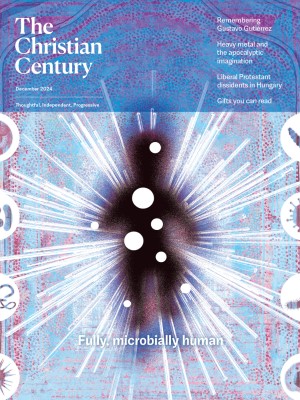December 8, Advent 2C (Baruch 5:1-9; Luke 1:68-79; Philippians 1:3-11; Luke 3:1-6)
Being baptized requires becoming vulnerable to at least one other person.
The prophets of the Old Testament knew how to get a crowd’s attention. When they delivered a message of repentance, it was hard to miss: they wore hair shirts and smeared themselves with ashes. They had visions of angels. They walked into lions’ dens or got swallowed by giant fish.
By the time of Jesus, these stories had been around for generations. The book of Jonah was 400 years old; Isaiah, 800. The texts were still familiar, read aloud regularly in worship, but they were no more contemporary to their readers than Shakespeare or Chaucer is to us.
Read our latest issue or browse back issues.
And yet, the coming of the Savior is foretold by none other than John, the son of Zechariah: a creative anachronism in the flesh, wearing a hair shirt, eating locusts, quoting an 800-year-old book, and demanding baptism for the repentance of sins. Something about his presence is so compelling that crowds flock to the desert for a chance to hear his preaching, and believers line up for immersion in the River Jordan. He proclaims a message from Isaiah—“Prepare the way of the Lord, make his paths straight” (40:3)—and manages to make it exciting and new.
The real excitement, of course, comes from John’s announcement that the scripture is finally about to be fulfilled. His audience in the Judean countryside is likely familiar with the rest of this passage from Isaiah. After the threatening images of mountains being bulldozed and valleys filled in, there comes the prophecy that, in John’s version, “all flesh shall see the salvation of God.” The original text offers more detail: “Then the glory of the Lord shall be revealed, and all people shall see it together, for the mouth of the Lord has spoken” (Isa. 40:5). The first-century Jewish community in and around Jerusalem, living under Roman occupation, is desperate for that revelation of glory. John’s promise that it is coming soon gives them cause for hope.
That hope is reinforced by John’s choice of Isaiah 40 as his prophetic text. Of all the passages in scripture that seem to foretell the coming of a messiah, this is one of the most joyful, projecting God’s mercy rather than God’s vengeance: “Comfort, O comfort my people. . . . Speak tenderly to Jerusalem” (40:1–2). God “will feed his flock like a shepherd” (40:11). In tying this passage to the baptism of repentance, John suggests that immersion in water represents an immersion in God’s mercy. That mercy will, of course, be ultimately fulfilled in Jesus Christ and affirmed when the Holy Spirit descends at the moment of Jesus’ own baptism by John.
John’s insistence on baptism points toward one important quality of God’s mercy and perhaps offers us a glimpse of what it will take for all flesh to see the salvation of God. Just as our understanding of God’s faithfulness is rooted in grace, it is also rooted in human interdependence. No mainstream church tradition recognizes the validity of self-baptism. In order to make this powerful affirmation of faith, a Christian must become vulnerable to at least one other person, who will pour the water or guide the immersion. The act of baptism is itself a reminder that our individual salvation is intertwined with that of the entire body of Christ.
This theme of interdependent survival resonates throughout the other readings. In the apocryphal Baruch, Jerusalem is restored only once her scattered children return from all the corners of the earth; in the Song of Zechariah, just after John’s birth his father sings the praises of the God who “has raised up a mighty savior for us . . . that we would be saved from our enemies.” Writing from prison, Paul praises the Philippians as his “partners in God’s grace” and makes clear that this partnership is sustaining him through his suffering. Jesus is the one who comes to save each of us, but we are unwise to forget that he has come for all of us—not as the private savior to individuals but as the One who offers salvation to the entire world.
As Christmas draws near, the demands of the season make it easy to turn inward. It is hard to think too much about collective salvation, or even collective needs, when our own families and friends (and, perhaps, congregations) take up so much of our attention. Yet, in the midst of all the gift shopping and family negotiations, John the Baptist is shouting in the desert. He invites us to a new humility, a new repentance, and a new acceptance of our reliance on each other. Are we ready to listen?





